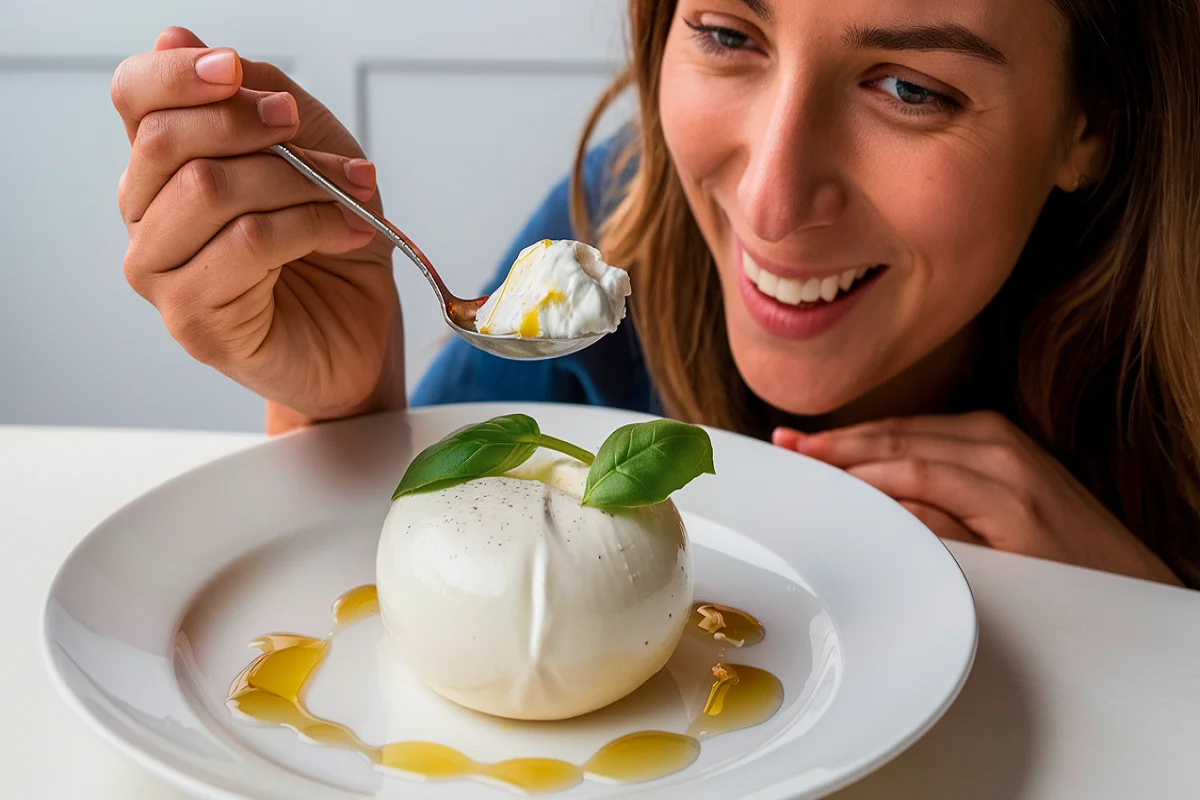Burrata cheese is a fresh Italian cheese that has garnered a global reputation for its rich, creamy texture and indulgent flavor. Often described as a combination of mozzarella and cream, this luxurious cheese offers a unique sensory experience that is unlike any other. If you’ve ever asked yourself what does burrata cheese taste like, the answer lies in its subtle, delicate flavors and its contrast of textures. Burrata has a flavor that is mild yet buttery, with an intense creaminess that melts in your mouth. In this article, we will dive deep into what makes burrata so special, exploring its flavor, texture, and how it compares to other cheeses, along with pairing suggestions to elevate your burrata-eating experience.
Introduction
Burrata cheese, at its core, offers a flavor that is subtly sweet, with hints of fresh milk and a buttery richness that is both light and decadent. The outer layer of burrata is made of mozzarella, giving it a slight firmness, while the inside is filled with a creamy, soft mixture of stracciatella (shredded mozzarella) and cream. When you cut into burrata, the center oozes out, creating an experience that is both visually and gastronomically stunning. In this article, we’ll explore what burrata cheese tastes like, and how its delicate flavor can be complemented with different ingredients and pairings.
Flavor Profile of Burrata Cheese
Burrata cheese has a unique flavor profile that sets it apart from other fresh cheeses. To better understand its taste, we’ll break down the specific characteristics that make it so delicious.
1. Creaminess and Richness
One of the defining qualities of burrata cheese is its creaminess. The interior of burrata, filled with stracciatella and cream, gives it a velvety, buttery texture that melts in your mouth. This rich, creamy center contrasts beautifully with the slightly firmer mozzarella shell, providing a balance of textures that elevates the entire eating experience.
2. Mild and Milky Flavor
Burrata has a mild flavor that is similar to fresh mozzarella, but with added depth due to its creamy center. The taste is reminiscent of fresh milk, with a subtle sweetness and a clean, delicate flavor that isn’t overpowering. Burrata’s lightness allows it to pair well with a variety of ingredients, from savory to sweet.
3. Slight Tanginess
Though burrata is predominantly known for its mildness, there is a slight tanginess to the cheese, especially when it is fresh. This tang comes from the fermentation of the cream and the natural flavors of the cheese itself. The tangy notes are subtle but provide a nice contrast to the overall richness.
Texture of Burrata Cheese
The texture of burrata cheese is another factor that greatly contributes to its overall flavor experience. Burrata’s texture can be broken down into two main components: the mozzarella outer shell and the creamy interior.
1. Mozzarella Shell
The outer shell of burrata is made of mozzarella, which has a slightly firm and elastic texture. This outer layer holds the creamy filling inside and provides a pleasant contrast when you cut into the cheese. The mozzarella shell is soft yet structured enough to give burrata its characteristic shape.
2. Creamy Interior
The inside of burrata is where the magic happens. The creamy mixture of stracciatella and cream gives the cheese a luscious, buttery texture that literally spills out when cut. This creamy center is what makes burrata so indulgent and different from other cheeses. The texture is smooth, rich, and almost liquid-like, providing a melt-in-your-mouth experience.
How Burrata Cheese Compares to Other Cheeses?

When asking what does burrata cheese taste like, it’s helpful to compare it to other popular cheeses. While burrata is often likened to mozzarella, its flavor and texture are distinct due to its creamy interior.
1. Burrata vs. Mozzarella
Burrata and mozzarella share some similarities, especially in their outer layers. Both have a mild, milky flavor, but burrata’s creamy center gives it a much richer and more indulgent taste. Mozzarella is firmer and more elastic throughout, while burrata offers a dual-texture experience with its soft center.
2. Burrata vs. Ricotta
Burrata’s creamy interior can be somewhat similar to ricotta in terms of texture, but their flavors differ. Ricotta is milder and grainier, while burrata is smoother and has a richer, more buttery flavor due to the cream. Burrata also offers more complexity in texture, with the firmer mozzarella shell providing a contrast to the creamy interior.
3. Burrata vs. Cream Cheese
Although burrata and cream cheese both have creamy textures, burrata is lighter and less tangy than cream cheese. Burrata’s flavor is more delicate and milky, while cream cheese has a stronger, slightly sour taste. Burrata also has the added bonus of its firm outer shell, which cream cheese lacks.
How Should Burrata Be Eaten to Best Experience Its Flavor?
Now that we’ve explored what burrata cheese tastes like, let’s discuss how to best enjoy its flavor. Burrata is versatile and can be served in a variety of ways, but there are a few tips and tricks that will help you maximize the flavor and texture of this luxurious cheese.
1. Serve at Room Temperature
To fully appreciate the creamy texture and delicate flavor of burrata, it should always be served at room temperature. This allows the creamy center to soften and the flavors to open up. Take the burrata out of the refrigerator about 30 minutes before serving to let it reach the optimal temperature.
2. Pair with Simple Ingredients
Burrata’s flavor is best complemented by simple, fresh ingredients. Its mildness pairs well with fresh tomatoes, basil, arugula, and a drizzle of high-quality olive oil. You can also add a sprinkle of sea salt and cracked black pepper to enhance the natural flavors of the cheese.
3. Add a Touch of Acidity
To balance out the richness of the burrata, add a touch of acidity. A drizzle of balsamic glaze or a squeeze of lemon juice can help cut through the creaminess and bring a refreshing contrast to the dish.
Pairing Suggestions for Burrata Cheese
Burrata is a versatile cheese that pairs beautifully with both savory and sweet ingredients. Here are some pairing suggestions to help you elevate your burrata experience:
1. Tomatoes and Basil
A classic combination, burrata pairs perfectly with ripe tomatoes and fresh basil. The acidity of the tomatoes and the herbaceous flavor of the basil balance the richness of the cheese. Add a drizzle of olive oil and a pinch of sea salt to complete this simple yet delicious dish.
2. Seasonal Fruits
Burrata also pairs beautifully with fresh, seasonal fruits. Try serving it with sliced peaches, figs, or strawberries. The sweetness of the fruit complements the creaminess of the burrata, creating a perfect balance of flavors.
3. Grilled Vegetables
For a savory pairing, serve burrata alongside grilled vegetables such as zucchini, eggplant, or asparagus. The smoky flavors from the grilled vegetables contrast nicely with the fresh, creamy cheese.
4. Prosciutto and Arugula
For a more substantial dish, pair burrata with prosciutto and arugula. The salty, savory flavor of the prosciutto and the peppery bite of the arugula balance the richness of the cheese, making for a satisfying and delicious meal.
5. Crusty Bread
One of the simplest ways to enjoy burrata is with crusty bread. Tear open the burrata and spread the creamy center over a slice of fresh or toasted bread. The combination of textures , crunchy bread and soft cheese—is irresistible.
Frequently Asked Questions (FAQs)
1. What Does Burrata Cheese Taste Like Compared to Mozzarella?
Burrata has a richer, creamier taste compared to mozzarella. While both cheeses have a mild, milky flavor, burrata’s creamy center gives it an indulgent, buttery texture that melts in your mouth. Mozzarella, on the other hand, is firmer and more elastic, with a simpler flavor profile.
2. Can Burrata Be Cooked?
Burrata is best enjoyed fresh and is not typically cooked, as heating it can cause the creamy center to lose its texture. Instead, it’s often added to dishes after cooking, such as placing burrata on top of pizza or pasta just before serving. This allows the cheese to maintain its creamy interior while still blending with the other ingredients.
3. What Should Burrata Be Paired With?
Burrata cheese pairs well with a wide variety of ingredients, from fresh tomatoes and basil to seasonal fruits like peaches and figs. It also pairs beautifully with grilled vegetables, prosciutto, arugula, and crusty bread. For a balanced flavor, add a touch of acidity, such as balsamic glaze or lemon juice, to cut through the richness of the cheese.
4. How Long Does Burrata Last?
Burrata is best eaten fresh and should be consumed within 24 to 48 hours of purchase for optimal flavor and texture. If stored in the refrigerator, burrata can last for up to five days, but the texture may start to deteriorate over time. Always store burrata in its liquid and in an airtight container.
5. Is Burrata Healthier Than Other Cheeses?
Burrata cheese is a rich and indulgent cheese, so it is higher in fat and calories compared to other fresh cheeses like mozzarella. However, what does burrata cheese taste like also makes it a favorite, as it offers a mild, creamy flavor while being a source of protein and calcium. As with most indulgent foods, burrata can be enjoyed in moderation as part of a balanced diet.
Conclusion
Burrata cheese is a unique and indulgent cheese that offers a rich, creamy texture and a mild, milky flavor with hints of butter and a slight tang. Its soft, velvety center makes it a standout cheese that can be enjoyed in a variety of ways, whether paired with fresh vegetables, fruits, or crusty bread. Understanding what burrata cheese tastes like allows you to appreciate its versatility and elegance. With its delicate flavors and luxurious texture, burrata adds a touch of indulgence to any meal, whether served as an appetizer, in salads, or alongside seasonal ingredients.

